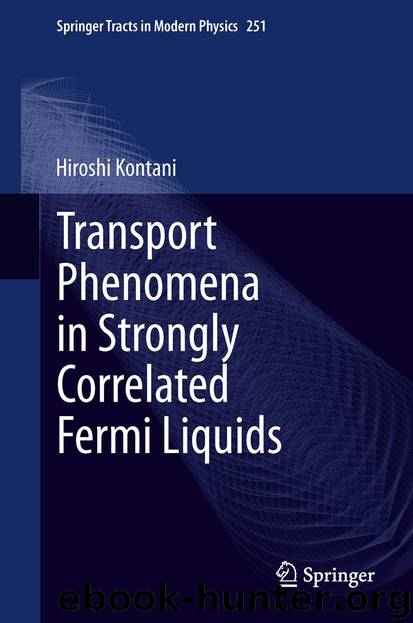Transport Phenomena in Strongly Correlated Fermi Liquids by Hiroshi Kontani

Author:Hiroshi Kontani
Language: eng
Format: epub
Publisher: Springer Berlin Heidelberg, Berlin, Heidelberg
(6.4)
where the kernel function is , and represents the -matrix defined in Eq. (6.1). The detailed method of calculation is explained in Ref. [24].
As shown in Figs. 5.3a and 5.6a, both and start to decrease below (160 K), consistently with experiments [28–30]. Figure 5.2a shows the resistivity given by the FLEX approximation and the -matrix approximation, both of which are given by including CVCs. As pointed out in Ref. [33], given by the FLEXCVC method shows a tiny “kink” structure at , actually observed in LSCO [34] and YBCO [35]. In addition, large kink structure appears at in the [-matrix]CVC method, since the inelastic scattering is reduced by the formation of the strong pseudo-gap. As shown in Fig. 6.1d, Im decreases quickly below , in accordance with the emergence of Im. As a result, below . To summarize, , and are suppressed in the pseudo-gap region.
Fig. 6.2 a for LSCO in the [-matrix]CVC; The modified Kohler’s rule holds above . Below K, modified Kohler’s rule is violated since increases quite drastically that is caused by the CVC due to AFSC fluctuations. b for LSCO in the [FLEX-matrix]CVC; the abrupt increase in below is caused by the CVC due to AFSC fluctuations. Experimental data is cited from [38–40]. c for NCCO obtained by the FLEXCVC approximation. Experimental data is cited from [41]. (Reference [42])
Download
This site does not store any files on its server. We only index and link to content provided by other sites. Please contact the content providers to delete copyright contents if any and email us, we'll remove relevant links or contents immediately.
| Automotive | Engineering |
| Transportation |
Whiskies Galore by Ian Buxton(41524)
Introduction to Aircraft Design (Cambridge Aerospace Series) by John P. Fielding(32885)
Small Unmanned Fixed-wing Aircraft Design by Andrew J. Keane Andras Sobester James P. Scanlan & András Sóbester & James P. Scanlan(32569)
Craft Beer for the Homebrewer by Michael Agnew(17927)
Turbulence by E. J. Noyes(7693)
The Complete Stick Figure Physics Tutorials by Allen Sarah(7135)
Kaplan MCAT General Chemistry Review by Kaplan(6590)
The Thirst by Nesbo Jo(6432)
Bad Blood by John Carreyrou(6271)
Modelling of Convective Heat and Mass Transfer in Rotating Flows by Igor V. Shevchuk(6219)
Learning SQL by Alan Beaulieu(6029)
Weapons of Math Destruction by Cathy O'Neil(5823)
Man-made Catastrophes and Risk Information Concealment by Dmitry Chernov & Didier Sornette(5641)
Digital Minimalism by Cal Newport;(5388)
Life 3.0: Being Human in the Age of Artificial Intelligence by Tegmark Max(5182)
iGen by Jean M. Twenge(5157)
Secrets of Antigravity Propulsion: Tesla, UFOs, and Classified Aerospace Technology by Ph.D. Paul A. Laviolette(4974)
Design of Trajectory Optimization Approach for Space Maneuver Vehicle Skip Entry Problems by Runqi Chai & Al Savvaris & Antonios Tsourdos & Senchun Chai(4837)
Electronic Devices & Circuits by Jacob Millman & Christos C. Halkias(4741)
